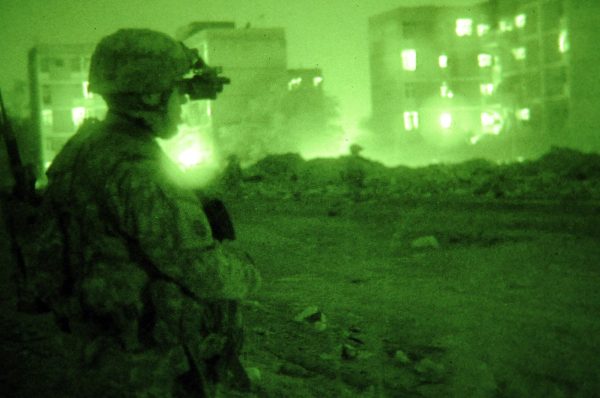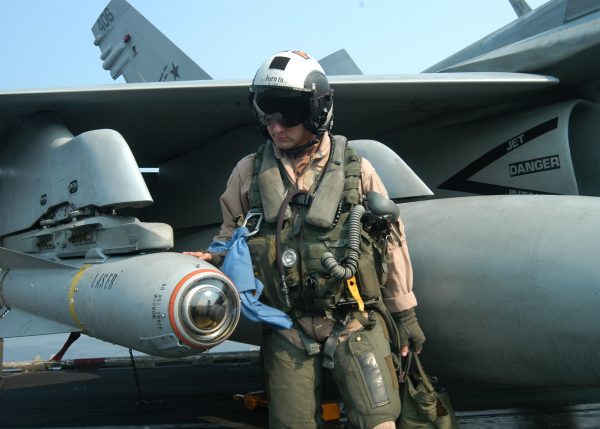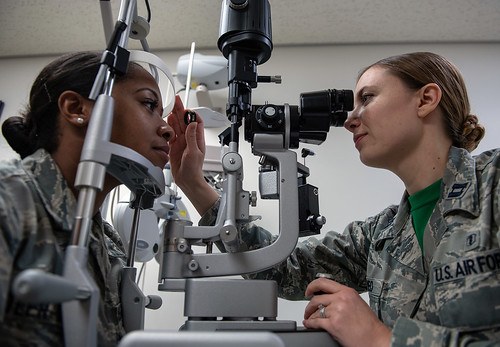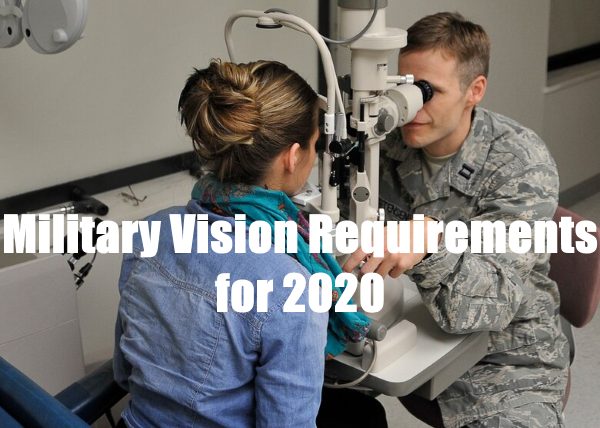Getting into the military is not as simple as it used to be where you show up to an office and are sent to basic training.
The modern military standards require an intense amount of screening to make sure each candidate is going to be able to fulfill their duties without any issues.
One of the most common areas that new military members struggle with understanding what vision they need to enter into specific branches of the military.
With this article, we hope to break down the specific requirements for each branch of service so you know whether or now you would be able to join the branch.
Related Article – Military Pilot Vision Requirements For Each Branch
Jump To A Section
Navy / Marine Corps Vision Requirements
Coast Guard Vision Requirements
List Of Vision Disqualifications in the Military
Army Vision Requirements

The Army is the largest branch of the military as it encompasses most of the ground movement and basic combat roles the military operates with.
Since the Army itself ranges from jobs like standard rangers to helicopter pilots, we need to look at some of the specific requirements for jobs within the Army.
In general, you need near and distance vision that corrects to an acuity of at least 20/40 in each eye.
Army Pilots
Pilots in the Army are not very common unless you are looking to pilot a helicopter or specialized Army aircraft.
Those pilots in the Army need to have vision that is or can be corrected to 20/20 in both eyes to qualify whether that is through glasses, contacts, or laser eye surgery.
Army Rangers
Army Rangers are the standard infantry unit for the Army, so their vision requirements align directly with the standard requirements for the Army branch as a whole.
Army Special Forces
The special forces are a more elite division of the Army that requires 20/70 or better in both eyes with both being correctable to 20/20 as they rely on strong vision.
Related Article – Your Complete Guide to MEPS
Navy / Marine Corps Vision Requirements

Despite the Navy being primarily based on the water, they also have a substantial amount of air power that requires a vision requirement.
Most of the standards for the Navy are going to be similar to other branches unless the job itself is highly specialized.
Navy SEALs
Despite being one of the most elite organizations in the entire Military, Navy SEALS only need a vision with 20/40 best eye; 20/70 worst eye; correctable to 20/25 with no color blindness.
Navy Pilots
A Navy or Marine pilot needs to have a base vision of 20/40 in both eyes that are correctable to 20/20.
Explosive Ordnance Disposal (EOD) Techs
The EOD requirements for the Navy are 20/20 bilateral correctable to 20/25 with no color blindness.
Navy Divers
Navy divers have the same vision requirements as Navy EOD specialists — 20/200 bilateral correctable to 20/25 with no color blindness.
Marine Recon
Marine Recon operators need to have a 20/200 visual acuity to qualify for the force.
Related Article – Navy Grooming Standards
Air Force Vision Requirements

As we saw with the Navy, Air Force requirements are not as strict as they once were with newer corrective technology helping candidates who need assistance.
In general, the Air Force follows the DoD directive for medical requirements for enlistment. For vision, this standard is distant visual acuity of any degree that corrects with spectacle lenses to at least 20/40 in each eye.
It also states that near visual acuity of any degree that correct with spectacle lenses to at least 20/40 in the better eye.
Air Force Pilots
A pilot must have normal color vision, a near visual acuity of 20/30 without correction, and distance visual acuity of no worse than 20/70 in each eye correctable to 20/20. There are also other standards for refraction, accommodation, and astigmatism.
Air Force Pararescue (PJ)
The pararescue distance vision requirement is uncorrected vision better than 20/100, correctable to 20/20. For near vision, the standard is 20/50 in the better eye, correctable to 20/20.
Air Force Combat Controllers (CCT)
The vision requirement of a CCT is the same as that of pararescue operators.
Tactical Air Control Party (TACP)
Vision requirements for TACP are the same as those for Air Force entry.
Combat Systems Officer (CSO)
The CSO requirements are going to be the same as the Air Force Pilot.
Related Article – Navy vs. Air Force
Coast Guard Vision Requirements

Being the smallest branch of the military, there are not many specialized jobs that the coast guard offers that present unique vision requirements.
Because of their small size and fairly standard operations, the Coast Guard has set their overall requirements as having a current distant visual acuity that corrects to any of the following degrees:
- 20/40 in one eye and 20/70 in the other eye
- 20/30 in one eye and 20/100 in the other eye
- 20/20 in one eye and 20/400 in the other eye
They also expect near visual acuity of any degree that corrects to at least 20/40 in the better eye.
The strength of the lenses someone wears and having normal color perception are also something that the Coast Guard will consider when picking applicants.
Related Article – Military Hearing Requirements and Disqualifications
List of Vision Disqualifications in the Military
Blindness
If someone is considered legally blind to a point where no correction will allow them to see, this is an immediate disqualification from every branch of the military.
Being blind in one eye is also going to be just as disqualifying as if you were to be blind in both eyes.
For obvious reasons, complete or partial blindness is going to disqualify you from military service as you will not be able to fulfill the duties required by being enlisted in the military at any level.
Color Blindness
While there is no specific standard for color vision in the military, you will be tested on your ability to perceive different colors when getting tested for the military.
The standard for color vision within the military revolves around the idea that you must be able to easily distinguish between different objects that vary in color by a significant amount.
This also means that you will need to be able to tell the distinct difference between objects that are red and green to prove you don’t have color blindness.
Being color blind is not disqualifying from any branch of the service. However, it may severely limit the jobs you’ll qualify for. Pilots require normal color vision in any branch of the U.S. Armed Forces.
Some branches narrow down jobs to the type of color blindness. In the Air Force, for example, color blindness is a pass/fail test. The Army, however, will determine if you are red/green colorblind or some other variation and set the jobs you qualify to do from those parameters.
Astigmatism
An astigmatism is a defect in the shape of an eye’s cornea that is not correctly shaped from either birth or another reason.
The reason this condition can be a disqualification is that some people who have astigmatisms have very blurry vision or poor image perception without very strong corrective lenses.
Because of this, any astigmatisms that are over 3 diopters are going to be an immediate disqualification for service while less intense astigmatisms will have to be tested to understand the viability of military service.
In light of that, you may be eligible for a waiver for an astigmatism of that magnitude.
Related Article – Basic Training Packing List for each Military Branch
Frequently Asked Questions
Can you wear glasses or contacts in the military?
This is one of the most commonly asked questions when people wonder if they qualify for service.
In the vast majority of cases, you can join the military and wear corrective lenses during your service. Many service members wear glasses or contact lenses.
Check with a recruiter for the branch you’re considering. It may depend on the acuity of your eyesight without glasses.
You’ll be able to wear contacts after basic training to correct your vision.
Can I get PRK or Lasik eye surgery?
Lasik is something that is considered by many who are about to or already in service with the military.
The elimination of the need for glasses is especially useful for pilots and combat troops.
In recent years, the rules surrounding PRK and Lasik have changed to allow people who have undergone the procedure to qualify for flight training and standard military operations.
Will the military pay for PRK / Lasik?
Depending on the situation and the need for vision correction, there are some cases in which the military may be able to subsidize some or all of the cost for Lasik or PRK procedures.
However, if you are hoping to join the military in hopes that they will cover the procedure cost for any random soldier, you are mistaken.
Are there any waivers for bad vision in the military?
As we have seen with many of the other issues involving vision, most vision issues that require waivers are looked at on a case-by-case basis.
This means that some candidates may be easily accepted into service with a waiver while others may require additional testing or be disqualified if they present a valid waiver.
Learn more about the Military Medical Waiver process for each branch of the military here.
Related Article – GT Score Explained: 5 Things To Know
Conclusion
No matter which branch of the military interests you the most, there are a lot of considerations you need to make regarding eligibility.
As we have seen with vision, there is much more that goes into the vision requirements than just how well you can see with or without glasses.
From the individual branches to specific jobs within those branches, there is a wide range of vision requirements that make a future candidate eligible.
We hope this information has helped you understand where you may want to look into the military now that you know a bit more about their vision requirements.
References
Understanding the MEPS Physical Exam
See Also:
20 Medical Conditions That Might Disqualify You From The Military
Can You Join The Military With Asthma?
Can You Join The Military With Flat Feet?
- Ikon Pass Military Discount: Learn How To Save Big - January 31, 2025
- RTIC Military Discount: Find Out How To Save Big on Gear - January 30, 2025
- Traeger Military Discount: Learn How To Save Big on Smokers - January 28, 2025


